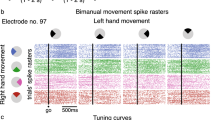Abstract.
Two mechanisms are described for controlling the movement of a pair of arms. The first is an engineered motion planner that finds solutions to the ill-posed problem of making noncolliding, goal-directed movements. The second uses neural networks that learn to emulate the coordinated behaviors of the motion planner using considerably less computational resources. Analysis of the networks shows in general terms how they work, and allows us to make testable predictions about some of the response properties that might be observed in the brain systems serving bilateral coordination.
Similar content being viewed by others
Author information
Authors and Affiliations
Additional information
Received: 12 March 1998 / Accepted in revised form: 10 November 1998
Rights and permissions
About this article
Cite this article
Farrar, D., Zipser, D. Neural network models of bilateral coordination. Biol Cybern 80, 215–225 (1999). https://doi.org/10.1007/s004220050519
Issue Date:
DOI: https://doi.org/10.1007/s004220050519




